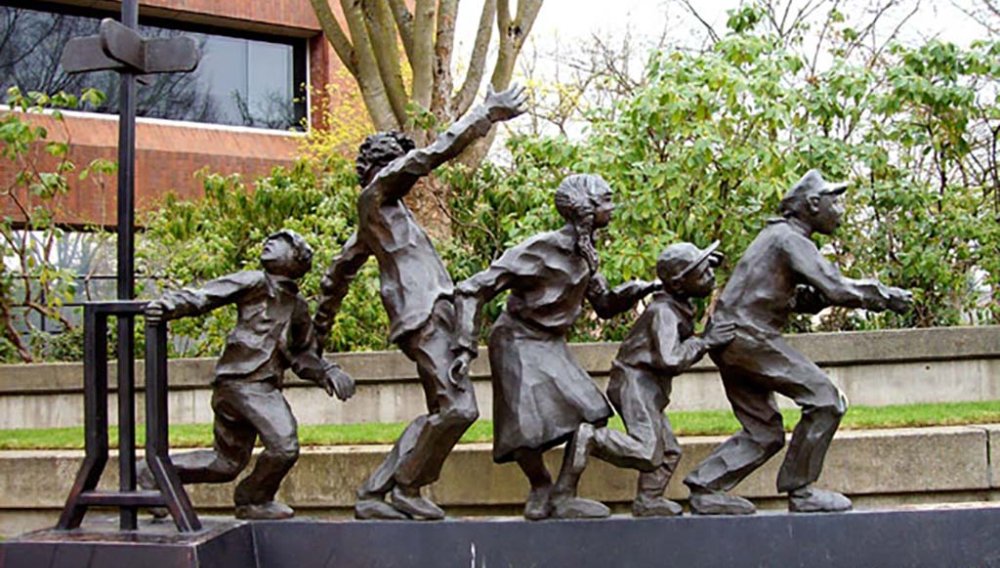Sculptor Richard Beyer has placed more art in Seattle public places than any other local artist. After gracing Seattle’s Fremont intersection with the now-famous passengers named “Waiting for the Interurban,” or the dramatic “Whale’s Tail” in the Alki playground or Madrona’s aluminum animals called “Peaceable Kingdom,” the artist left Seattle for the banks of the Columbia River at Pateros, Washington.
Years ago, I spent time with Rich in his private “Peaceable Kingdom” in his sprawling Okanogan country. We made frequent stops to tramp riverbanks, explore cliffside bird colonies, and banter with locals in Twisp and Methow.
Rich’s remote studio, with a large open door to the cold waters of the Columbia River (I jumped in the frigid flow off the prow of an old dock), held the usual jumble of artist’s tools and paraphernalia.
Before those halcyon years, Rich came to Seattle in 1957 with a Columbia University liberal arts degree, a master’s from Putney-Antioch, Vermont, and a clear eye for human foibles. The glint in his eye is reflected in his work. Freely mixing animals and humans as subjects of his work, he gave the preferred nod to members of the animal kingdom when portraying wisdom, strength, and wry humor. His works are bold, often over-sized, and emerge next to children’s playgrounds and urban streets.
For example, Beyer’s animals can be found in the smooth, quiet features of “McGilvra’s Farm” in Seattle’s Madison Park, the patiently observing sandstone “Three Dogs” in Belltown, and the reclining bull in downtown Ellensburg. Another friendly milestone is the captain’s chair in front of Ivar Haglund’s seagull on Seattle’s waterfront, which depicts the almost-smiling birds nuzzling against the torso of the benign seafood purveyor.
Newcomers to Seattle should know that Rich Beyer’s works each tell a local story. For example, the Fremont “Interurban” cluster reminds observers that Fremont was once a thriving independent village and key stop on the long-defunct Interurban Railroad which stretched from Everett to Tacoma. Rich suggested that his somber, patiently-waiting passengers represent a kind of protest “of what automobiles have done to our urban scene.”
Rich moved to New York, where he passed away surrounded by dreams of his characters. I attended a memorial service for him in Seattle’s Fremont neighborhood, with music and intense conversation everywhere about the public characters he left behind.
I once referred to Rich’s work as “public art,” which Rich gently suggested was actually “Art in public places.”
Discover more from Post Alley
Subscribe to get the latest posts sent to your email.

Why only one picture in this story, or at least a link or two with pictures?
Ruth Yeomans
Great story. My favorite aspect of Beyer’s ‘Waiting for the Interurban’ was the face he sculpted on the dog, which was of Fremont political leader Armen Stephanian with whom Beyer had public disagreements. My recollection is that shortly after the reveal, Stephanian shaved his mustache and beard in an attempt to look less like the dog. The other aspect is the fact that this work reminds us that before spending billions of dollars on our light rail system, which still isn’t finished and is having operational problems, we had an excellent light rail system that ran from Everett to Tacoma that we foolishly dismantled
What a nice tribute to this artist.
Thanks, Junius. Very nice article. You can take your place among Seattle’s notable recorders, if not artists. Bill Dunn
Armen is still in Ocean Shores, I think. The thing about the Waiting for the Interurban sculpture: They will be waiting perpetually, because the Interurban actually ran north/south on Fremont Ave, not where they are waiting on N. 34th.
George Tsutakawa has quite a few public sculptures. I was surprised to read the Rich Beyer has the most in public spaces.